G’Day! Welcome to 1930’s, alternate-reality Australia. From the fertile shore where you’ve landed you can see the lush green hills (perfect for grazing cattle incidentally) and lying beyond them stretches the vast interior. Where’s the gold you say? Why, it’s out there in the ground of course! The ochre outback has rewards rich for the taking – gold, iron, coal, even phosphate (you’ll be wanting some of that). Alternate-reality Australia is a vast continent of potential – bountiful, devoid of human inhabitants and waiting for you to exploit the hell out of it. What’s that? You want to know why there are so many armoured cars driving about? Ah, well… about that…
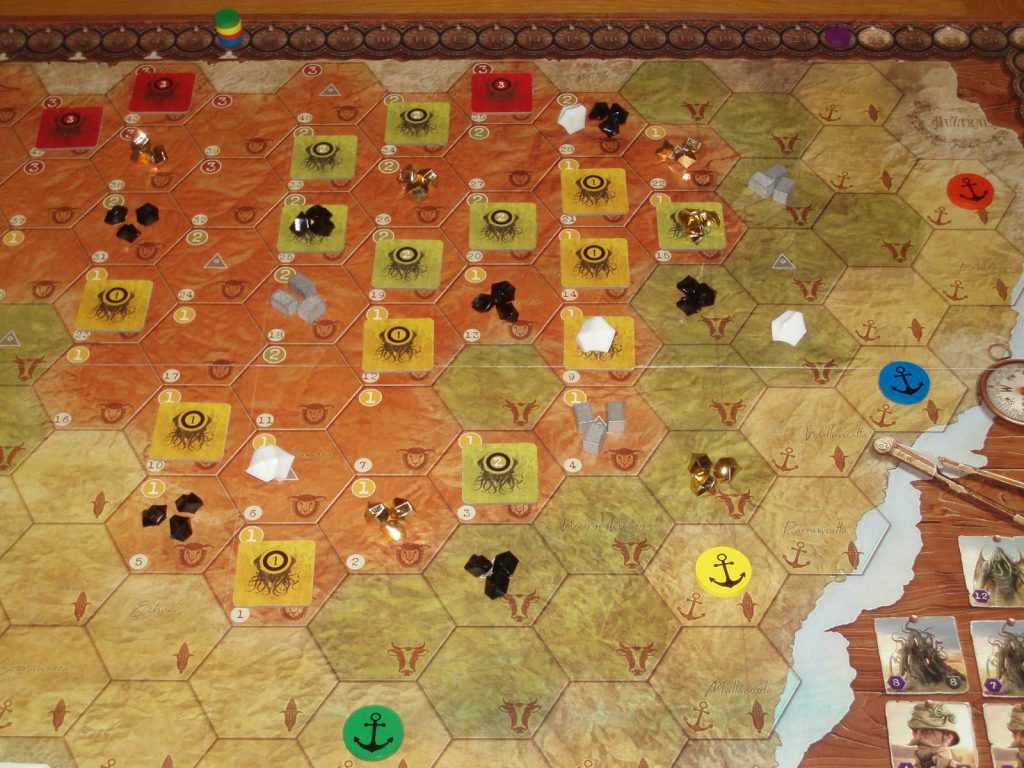
AuZtralia is a game of rail building, resource claiming and battling the great Old Ones that want to destroy humanity. In the game’s establishing narrative the Old Ones have nearly been driven from the Earth, save for a few that linger sleepily in the outback with their minions. Australia itself was abandoned centuries earlier but the times they are a-changing and the tantalising riches of the forgotten continent prove too irresistible for some.
Over the course of the game 1-4 players build railway networks from the coast into the heart of the outback, mining and farming as they go. If this was all there was, AuZtralia would be a perfectly solid game: decent but not exactly a strong contender in a crowded genre. What makes AuZtralia stand out from the crowd is that part way through the Old Ones start to awaken and cause havoc. As the game progresses it metamorphoses from an economic route-building game into a thematic war game, with players frantically battling hordes of ravaging monsters. Here at Meeple Mountain we publish a Board Game Mashups series. I think AuZtralia might just be this series distilled into a single game.
So, how does it all work?
AuZtralia comes with a double-sided game board covering the Eastern and Western halves of Australia (resulting in subtly different game experiences). A thematically-appropriate setup (more on this later) produces a randomly generated map of resources (iron, coal, gold and phosphate) and hidden Old Ones (from Levels 1 to 3 of increasing difficulty). Players establish their ports on the coast and expand into the continent by building railway tracks and founding farms. Along the way players can also buy their own private armies, mine for those precious resources and hire helpful characters.
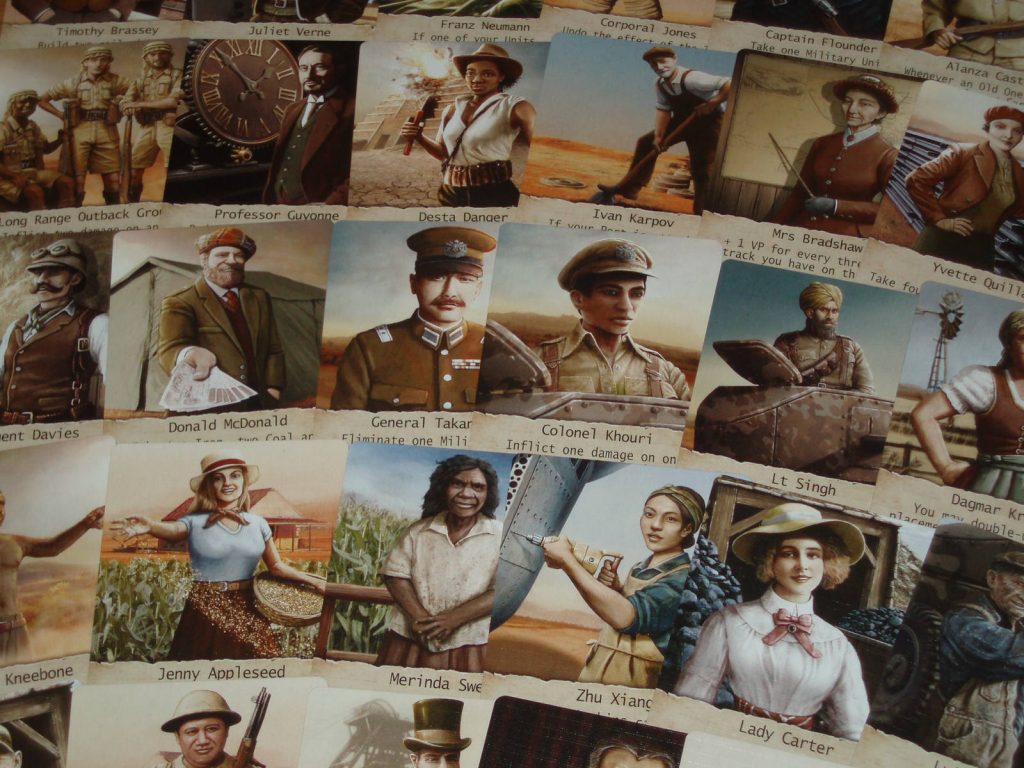
A third of the way into the game event cards start triggering the Old One resurgence. Once awoken, Old Ones move towards the nearest farm or port and it’s up to the players to stop them if they can (or want to). At the end of the game players get points for working farms and phosphate, as well as from character cards and from defeated Old Ones. The Old Ones get points from razed farms and from surviving revealed and hidden individuals. As a result, the game is semi-cooperative with players competing against each other and the Old Ones to have the most points – if the Old Ones win then everybody loses, otherwise the player with the most points is the winner. There’s also an entirely cooperative mode available with only a couple of minor rule tweaks.
Thinking Mechanically
AuZtralia’s designer, Martin Wallace, has an impressive pedigree along the spectrum of games from light (e.g. Discworld: The Witches) to heavy (e.g. Brass), and AuZtralia falls somewhere in the middle. The links between theme and mechanics help the first-time player get the hang of AuZtralia quickly. With the map spread out before you, it’s easy to start planning where you’d like to go and what you’d like to do. The player boards are similarly intuitive for the ‘how’. There are spaces for your resources and troops but otherwise the boards consist of a series of boxes displaying the ten actions available on your turn. There are a couple of awkward rules to remember (you should designate someone to learn how the Old Ones work when you first start) but otherwise it’s a surprisingly intuitive game. There’s Australia. There are the things you want. There are the things that will try to kill you. There’s your player board with what you can do. Go!
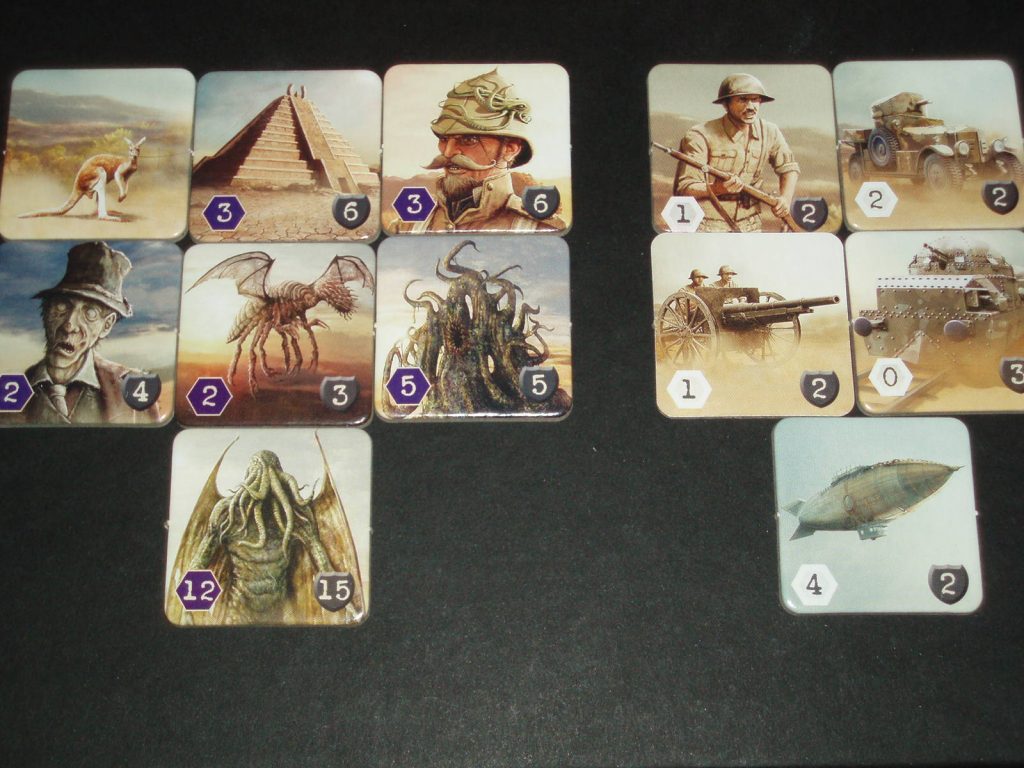
Of course, there’s more to it than that. Every turn is a balancing act, managing your resources and limited time. All actions cost you time, propelling your marker along the timer track, with the active player being whomever is furthest behind. It’s a turn order mechanic successfully implemented in a number of games (e.g. Glen More and it’s sequel) and means that players left behind can carry out multiple turns on the trot, but also that if you go big you may be waiting a while until your next turn. Can you afford to gift your opponents (including the Old Ones when they join the fray) so many actions before you get to make your next move? And given the limited amount of time before the game ends, can you really afford to waste time on a single large action when you could achieve so much with multiple small ones?
Compounding these thoughts is the action selection mechanic. Each action you carry out requires placing a marker on the associated space on your player board and every marker that’s already there increases the cost of that action. You can retrieve all your markers, but that in itself is an action that costs you precious time. When should you clear your board and when should you just suck it up and pay the extra costs?
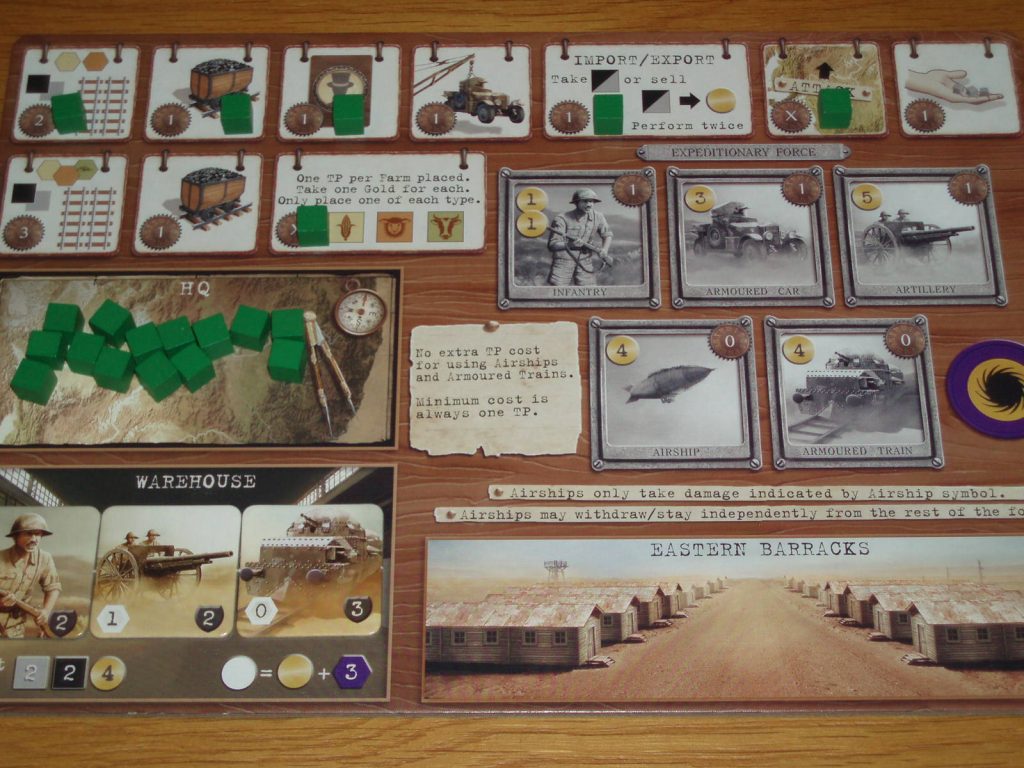
These twin mechanics make a strong puzzle in themselves but squatting on the board are the Old Ones, adding a further dimension to the decision space. You know where they are, you know that they’re drawn to farms… maybe the best thing is to forgo your plans and place some farms to alter their route away from your port, or even towards another player’s. But then again, the Old Ones get points for destroying farms and you get points for defeating them so perhaps you should attack them instead? The decisions in AuZtralia are interesting like this, satisfyingly chewy but not too dense.
Thinking Thematically
Let’s talk theme. AuZtralia is actually a thematic sequel to Martin Wallace’s earlier game A Study in Emerald, although you’d never know in terms of the gameplay and mechanics. AuZtralia’s themes of Cthulhu, zombies, trains and farms could feel like a board game greatest hits, the impact dull from over-familiarity. Yet it doesn’t. Partly this is due to its scale. Cthulhu and zombie games normally involve individual characters tackling the forces of evil but here the scope is larger – the Old Ones maraud across a continent, battled by armies rather than investigators clutching history books and pistols. Specifically, the use of a continent is grander than pottering around the streets of Arkham but without the impersonal detachment that a global map can bring.
The other way in which AuZtralia feels fresh is through the character of Australia itself. There are few meaningful experiences of Australia in board games. Here, the colour palette, the details that litter the board and the earthy characters for hire all create an impression that separates AuZtralia from being just another Cthulhu or train game. There’s very little green or blue, dark tones are almost entirely absent. Instead everything is slightly sun-baked, the colours muted but rich. AuZtralia shows clearly that a translocation to a different environment is enough to enliven a tired genre.

There’s a nice balance of theme and mechanics when it comes to luck too. The set-up and events are randomised and whilst the combat is balanced there’s still an element of chance involved (see below for how combat works). If you go in imagining this is an economic game with a few Cthulhu tentacles sprinkled on top this could be frustrating. Similarly, it could feel slow or staid if you approach it as a monster-bashing war game. But thematically it all works given the scale the game is operating at – you need the more gradual economic resource management aspects to build a route into AuZtralia and you need the thrill of adventure and battle when fighting the Old Ones. Additionally, the impact of luck mirrors the uncertainty of exploring a long abandoned continent, the random things that can occur on expeditions and the unpredictable triumphs and follies of war.
Crocodile Fundee or Bad Max?
I have a lot of admiration for AuZtralia: it’s tight, fast and fun. The game finishes far sooner than you expect, somehow catching you off guard despite the constantly visible timer track. It makes every turn meaningful. At lower player counts AuZtralia is really tough, even when playing co-operatively. My first few games ended in huge defeats. But it’s challenging in all the right ways, encouraging you to play again when suffering an early loss.
We often praise replayability in board games. Certainly the randomised set-up, double-sided board and event cards all provide that, but AuZtralia also has a rare meta-replayability. Repeated plays lead to a different game experience rather than simply getting better at the same game. Games shift from playing primarily to beat the Old Ones to competing against the other players around the table. This change happens less at higher player counts where the Old Ones are slightly easier to defeat, but then the increased competition between the players for limited resources makes up for this.
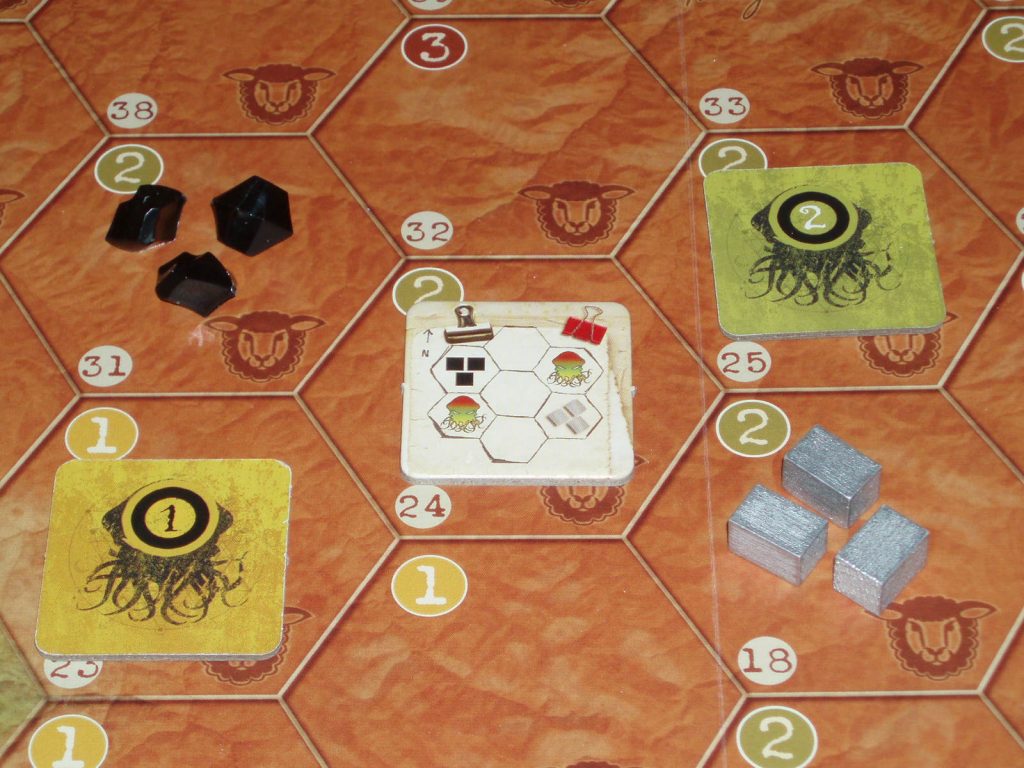
It’s not all roses and sunshine though. The board set up is ingenious and nicely thematic – survey tiles placed around the board reveal where resources and Old Ones start – but it’s a lengthy process. Whilst filling in the map like this is remarkably satisfying, it’s a job that can take several minutes by itself. And there are really only four different types of random event that spur the Old Ones into action which can start to feel repetitive. An unfortunate shuffle of the event cards can result in a game where few Old Ones are actually awoken unless you provoke them or a game where the waves of Old Ones are completely overwhelming. It’s part of the experience – reacting to whatever the continent holds this time round – but when you’ve just turned over your fourth Assassination card (removing two characters from the available market) it ends up feeling like something’s missing.
Thematically, the roster of characters available to hire is admirably diverse and includes a number of Aboriginal Australians. Unfortunately this is about the only acknowledgement that AuZtralia gives the continent’s indigenous populations. My reading of the rulebook and surrounding blurb is that the continent was abandoned by the Aboriginal Australians and they are amongst the first wave of settlers re-colonising the continent as part of the game. Yet this is never directly mentioned and despite my searching of the game itself and online I don’t know for sure. AuZtralia avoids the problematic colonisation issues of many games – developing land whilst simultaneously exterminating, exploiting and/or ignoring the native population – but a little more world building to more fully address what has happened to the Aboriginal Australians in this alternate-reality Australia wouldn’t have gone amiss.
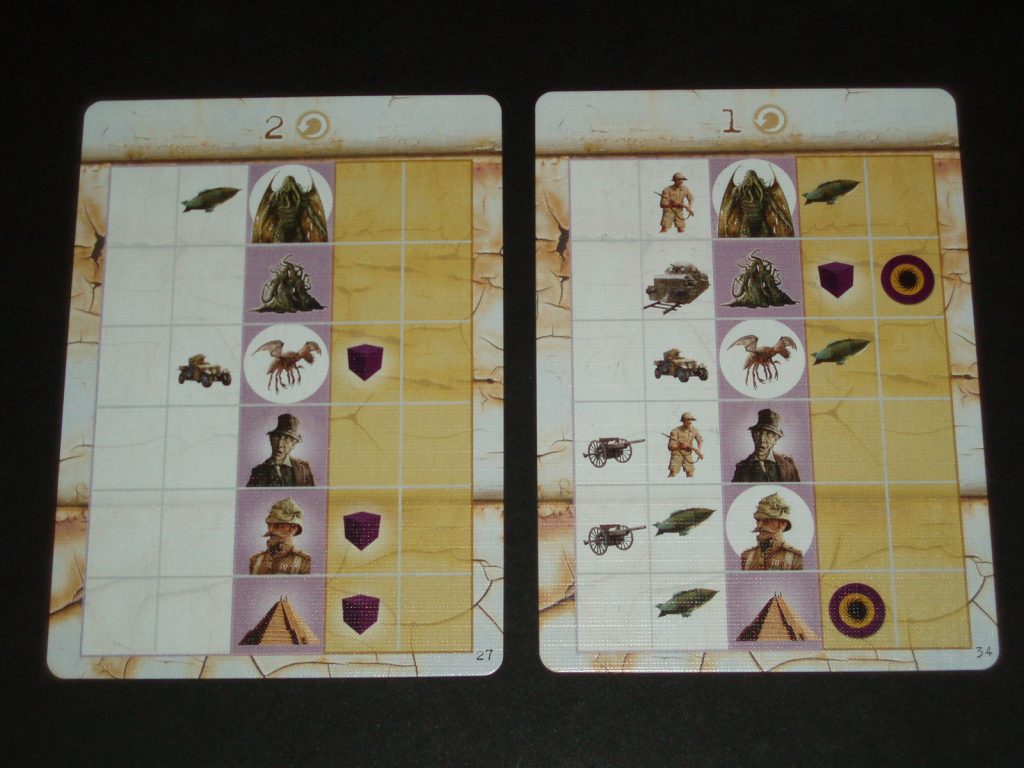
And then there’s the combat itself. You flip a card and look at the Old One row you are fighting – on the left is the damage that your troops do, on the right is the damage that the Old One does to you. Different troops are effective against different Old Ones and the cards are a way of modelling this, whilst keeping the combat balanced and snappy. But frequently you turn cards over and nothing happens – either because your troop types aren’t on the card or there’s just nothing on either side. If you follow the table in the rulebook that tells you which troop types are most effective against which Old Ones then this happens less, but if you urgently need to take down an Old One and you don’t have the most suitable troop type to hand then you could be turning over cards for a while, both sides repeatedly failing to do anything. In one game we cycled through half the deck before what was quite a small scuffle was resolved (although this was partly our fault for sending in the least suitable troop type).
The way combat works could spoil the game for some people, with the danger of turning visceral battle into a spreadsheet. Knowing the cards are balanced seems to dampen the thrill of fate, especially when nothing happens. Yet it’s worth sticking with. Combat in AuZtralia acts as a bridge between the economic and thematic elements of the game, ensuring that these different aspects are not disconnected and allowing you to make meaningful decisions. Crucially, when it works it’s fantastically tense, everything hinging on the flip of a card.
These various issues will be enough to put some people off. Whilst I personally enjoy the combat mechanic, I’d like to have seen a little more variability in the event cards and maybe even with the Old Ones themselves. I can see the logic behind the decisions – increasing randomness through events might skew the delicate balance of the more economic aspects – but all the same I’d love to see a small expansion to strengthen this side of the game.
Yet despite these minor blemishes, I’m a huge fan of AuZtralia and what it aims to achieve. It’s rules-heavy but intuitive. Medium-weight but quick. It’s an economic game of resource management but frequently you’re just trying to defeat big monsters with your artillery and zeppelins. It’s about colonising a land mass but refreshingly the indigenous population aren’t completely glossed over or exploited (although see my previous concerns) and there’s a reason why the continent was abandoned. Combat involves looking things up in tables, but can be just as thrilling as rolling a handful of dice. It’s about Cthulhu, zombies, trains and farms but it feels fresh. It’s got trains but they’re armoured. Martin Wallace has created the ultimate board game mashup, the seemingly disparate elements pulling it in all directions and yet it’s a success. Bonza!


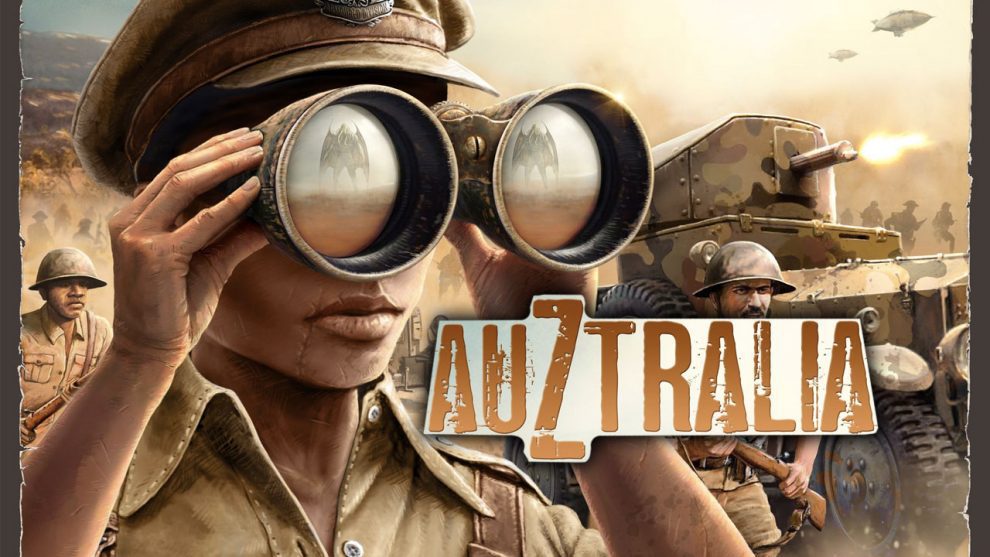


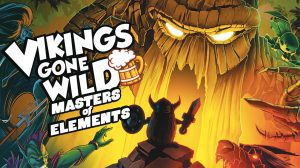






Add Comment